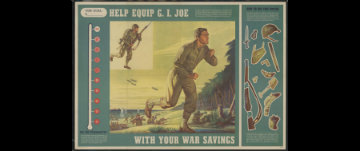
In partnership with Musselman Library, students in Associate Director Jill Ogline Titus’s Fall 2019 Introduction to Public History (HIST 301) class curated a multi-layered digital project about the strategic operations of wartime propaganda. Shaping Perceptions of War: Propaganda Posters in World War II is built around interactive visual maps (and a comparative timeline) of 15 posters from the United States and Canada that provide a visual snapshot of the propaganda art that shaped life on the homefront between 1941 and 1945. In addition to exploring the history and operational impact of these posters, the project allowed the students to draw on course readings and discussions about material and visual culture, historical interpretation, and digital history to construct visual stories that annotate and enliven their selected posters.
Special Collections & College Archives, Musselman Library is home to a remarkable collection of 114 World War II propaganda posters. The majority are related to the American homefront, although Allied nations such as Great Britain, France, and Canada are represented in the collection as well. This primary source collection began as an effort to teach about World War II through visuals produced during the era. The bulk of the collection came to Gettysburg College through a collaborative preservation project with the Adams County Historical Society. The entire collection can be viewed on GettDigital.
During World War II, propaganda posters produced under the auspices of the Office of War Information and the War Advertising Council were a fixture of daily life in the United States. From their ubiquitous positions in shop windows, post offices, streetcars, trains, and office/factory breakrooms, the posters kept the war effort constantly in Americans’ sightlines as they went about their daily business. Visually eye-catching and relatively inexpensive and easy to produce, the posters sought to shape the behavior of citizens in ways that would support the nation’s military effort; they implored Americans to sacrifice, conserve resources, pursue war-related work and volunteer service, purchase war bonds, police their speech/behavior, and enlist in the military, among other desired aims. While many posters were aimed at the broadest audience possible, others were targeted to certain segments of the population, such as homemakers, factory workers, farmers, racial minorities and young people of enlistment age. As artifacts of the 1940s, some of these posters reflect ideas about race, gender, and war aims that are troubling to modern audiences yet nonetheless provide valuable windows into the ways that everyday Americans experienced World War II.
The HIST 301 project provided the students space and tools to analyze the visual strategies employed by the posters, their content and message, and their likely intended audience, and then construct their own visual stories about them for a 21st-century audience. In constructing their own stories, students had to consider how to best make use of their digital toolkit (comprised of StoryMap JS, Timeline JS, and Scalar) to present the posters to a digital audience; apply guidelines for interpreting material/visual culture discussed over the course of the semester; and ask difficult questions about what these posters simultaneously reveal and obscure about the US and Canada’s experience in World War II. Ultimately, the students collectively decided to focus on four key themes emerging from the posters themselves: control, forging victory, justice for the fallen, and women & gender. Their work is now accessible in a public-facing Scalar site that invites viewers and visitors to see these posters in a new light.
The collaborative support team behind the project was made up of R.C. Miessler, Systems Librarian, Musselman Library and Digital Scholarship Committee member; Carolyn Sautter, Amy Lucadamo and Catherine Perry of Special Collections & College Archives, Musselman Library; and Digital Scholarship Fellow Emma Lewis ‘20, who built the Scalar site housing the project.